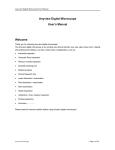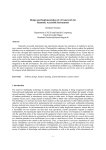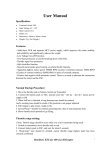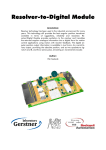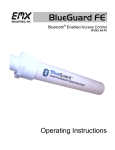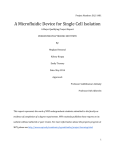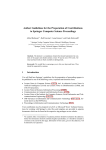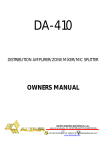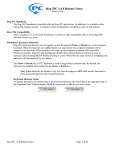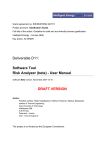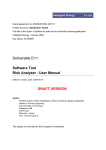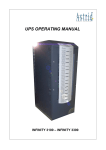Download Learning-Tool - Neural Micro circuits
Transcript
Learning-Tool : Analysing the Computational Power of neural microcircuits Version 1.0 User Manual c 2002 The IGI LSM Group www.lsm.tugraz.at June 11, 2006 This document is part of Learning-Tool Version 1.0 Copyright 2002 The IGI LSM group Learning-Tool is free software; you can redistribute it and/or modify it under the terms of the GNU General Public License as published by the Free Software Foundation; either version 2, or (at your option) any later version. Learning-Tool is distributed in the hope that it will be useful, but WITHOUT ANY WARRANTY; without even the implied warranty of MERCHANTABILITY or FITNESS FOR A PARTICULAR PURPOSE. See the GNU General Public License for more details. To get a copy of the GNU General Public License point your browser to http://www.gnu.org/copyleft/gpl.html. The IGI LSM group Institute for Theoretical Computer Science Graz University of Technology Inffeldgasse 16/b, A-8010 Graz, AUSTRIA [email protected], www.lsm.tugraz.at Contents 1 Introduction 3 1.1 What is Learning-Tool ? . . . . . . . . . . . . . . . . . . . . . . . . . . . . . . 3 1.2 About this manual . . . . . . . . . . . . . . . . . . . . . . . . . . . . . . . . . 3 1.3 Features of the current version . . . . . . . . . . . . . . . . . . . . . . . . . . 3 1.4 Getting and Installing Learning-Tool . . . . . . . . . . . . . . . . . . . . . . . 3 2 An Introductory example 4 2.1 Algorithm for offline training of the threshold gate . . . . . . . . . . . . . . . 5 2.2 Basic Concepts . . . . . . . . . . . . . . . . . . . . . . . . . . . . . . . . . . . 5 2.3 Implementation with Learning-Tool . . . . . . . . . . . . . . . . . . . . . . . . 6 3 Function reference 8 2 1 Introduction 1.1 What is Learning-Tool ? Learning-Tool is a set of Matlab scripts that allows to asses the the real-time computing capability of neural microcircuit models. Learning-Tool is based on a new theoretical framework for analysing real time computations in neural microcircuits: the Liquid State Machine (Sec. ??). To get a thorough understandig of Learning-Tool it is a good idea to read the paper describing the basic ideas[Maass et al., 2002] as well as the paper which describes on a higher level this software package[Natschläger et al., 2002a]. 1.2 About this manual This manual is intended to describe how to use the Matlab scripts provided by Learning-Tool to perform computer experiments within the LSM framework. We assume that the reader has Matlab programming knowledge. Although a short introtuction into the basic concept of the LSM (Sec. ??) is given we strongly recommend to read [Maass et al., 2002, Natschläger et al., 2002b]. This manual is also available in HTML format either online via http://www.lsm.tugraz. at/learning/usermanual or locally at your computer as file:<somepath>/lsm/learning/ documentation/usermanual/index.html if you have installed (unzipped) Learning-Tool in the directory <somepath>. 1.3 Features of the current version Matlab interface Learning-Tool is mainly written in Matlab and hence Runs under Unix (Linux) and Windows Object oriented design All the Learning Algorithms (Sec. ??), target functions (Sec. ??), and readouts (Sec. ??) are implemented as Matlab classes. Parallel Processing Usually the training of a readout (Sec. ??) involves many simulations of the same microcircuit with different inputs and training of several readouts. This can easily be run in parallel. Learning-Tool provides means to do this in a convinient way (by employing the Parallel Matlab Toolbox [Svahn, 2001]). 1.4 Getting and Installing Learning-Tool Learning-Tool is distributed under the GNU General Public License and can be downloaded from http://www.igi.tugraz.at/learning. To install Learning-Tool perform the following steps: 1. Donwload Learning-Tool from http://www.igi.tugraz.at/learning 3 microcircuit threshold gate input spike train Figure 1: Architecture used to classify a spike train. The microcircuit is modeled as a network of leaky-integrate-and-fire neurons. 2. Unzip the file learning-tool-VER.zip where VER stands for the version you have downloaded. This will create a subdirectory lsm and lsm/learning 3. Start Matlab and change into the directory lsm 4. Run the Matlab script install.m. 5. Add the path lsm to the Matlab search path; e. g. • addpath(’/home/jack/lsm’)} or • addpath(’C:\Work\Neuroscience\lsm’). 6. Change into the directory lsm/learning/demos and play around with them. Have fun using Learning-Tool ! 2 An Introductory example In this section we will introduce Learning-Tool by means of an introductory example. In this simple example we will train a readout neuron modeled as a threshold gate (see [Hertz et al., 1991]) to classify a spike train. This readout neuron will receive its input from a neural microcircuit modeled as a network of leaky-integrate-and-fire neurons (see [Gerstner and Kistler, 2002]) which is stimulated by the input spike train (which should be classified). The setup is shown in Figure 1. 2.0.1 Precise definition of the classification task Two Poisson spike trains (freqency 20 Hz, length 0.5 sec) are generated, and fixed as templates 0 and 1. The actual input spike train is generated as jittered versions of a template by varying each spike by a random drawn amount (Gaussion distribuion with zero mean and a given STD; this STD is called jitter (default jitter=4 ms)). The task of the threshold gate is to output 4 the number (0 or 1) of the (random choosen) template from which the input spike train was generated. 2.1 Algorithm for offline training of the threshold gate Here we just outline the main body of the procedure which we will use to train the readout. This will be discussed in more detail in Section ??. 1. Define the neural microcircuit to be analyzed 2. Record spike responses of the neural microcircuit caused by different training inputs drawn from an appropriate input distribution. 3. Convert the spike responses into states x(tk ) at various sample time points tk by some low-pass filtering to get a somewhat smoothed signal. This mimics the effect of spike transmission through a synapse to its postsynaptic neuron. This transformation can also be dropped if one can cope directly with the spike response. 4. Apply a supervised learning algorithm to a set of training examples of the form h state x, target-value yi to train a readout function f (a threshold gate in the case of this example) such that the actual outputs f (x) are as close as possible to the target values y given by the target function. 5. Evaluate the performance of the trained readout (i.e. the threshold gate) on an independent set of test inputs (which are usually drawn from the same distribution as the training inputs). 2.2 Basic Concepts The above description of the basic algorithm (Sec. 2.1) implicitly introduced all the basic concepts we need to know to understand how Learning-Tool works: Input Distribution The distribution from which the training (and test) inputs are drawn. In our example the input distributio is defined byt the following simple procedure (for fixed templates 0 and 1): 1. Randomly choose template 0 or 1 2. Add noise (jitter) to each spike in the template Neural Microcircuit The circuit which receives the input and whos response is recorded and analysed (in our example this a network of 135 leaky-integrate-and-fire neurons). Response of the Microcircuit The response (output) of the neural microcircuit (in our example the 135 spike trains produced by the microcircuit model). State of the Microcircuit The transformed (smoothed) response (output) of the neural microcircuit (in this examples this corresponds to a low-pass filtered (30 ms) version of the spike trains). This transformation can also be dropped if one can cope directly with the spike response. 5 Sample Time Points Since we can only handle finite sets of training examples we must define time points at which we want to sample the state of the microcircuit (in this example we will sample the states every 25 ms). Readout Function A parameterized function/device which gets as input the circuit states (or in some cases directly the circuit response) an computes the outputs of the system (n this example a threshold gate). Target Function/Filter A function which defines for each input time series the target output time series of a readout function. In mathematical terms this should be a target filter since we are talking about computations on time series. Supervised Learning Algorithm By means of such algorithm the paramters of the readout — and only the readout — are adjusted such that the actual output of the readout matches as close as possible the target output. Training Set Set of inputs used to determine the parameter of the readout. Test Set Set of inputs different to the training set which is used to asses the performance of the trained readout. As we will see each of this terms has its corresponding element within Learning-Tool . 2.3 Implementation with Learning-Tool The full Matlab code is contained in lsm/learning/demos/spike train classification/spike class.m. Defining the input distribution Several input distributions are readly imlemented as Matlab objects. The class jittered templates (Sec. ??) provides the kind of input we need for our task. The followin code line generates a jittered templates object which produces single spike trains from 2 patterns with a jitter of 4 ms: InputDist = jittered_templates(’nChannels’,1,’nTemplates’,2,... ’Tstim’,0.5,’jitter’,4e-3); Creating the neural microcircuit model The following code generates a sparsely connected network of leaky-integrate-and-fire neurons. The details of the network creation are the topic of the Circuit-Tool User Manual and thus not described here. % init the model nmc = neural_microcircuit; % add a pool of 135 leaky-integrate-and-fire neurons 6 [nmc,p1] = add(nmc,’Pool’,’origin’,[1 1 1],’size’,[3 3 15]); [nmc,pin] = add(nmc,’Pool’,’origin’,[0 0 0],’size’,[1 1 1],... ’type’,’SpikingInputNeuron’,’frac_EXC’,1); % connect the input to the pools/pools nmc = add(nmc,’Conn’,’dest’,p1,’src’,pin,’Cscale’,0.9,... ’type’,’StaticSpikingSynapse’,’rescale’,0,’Wscale’,0.15,’lambda’,Inf); % add recurrent connections within the pools nmc = add(nmc,’Conn’,’dest’,p1,’src’,p1,’lambda’,2); % define the respones (i.e. what to record) nmc = record(nmc,’Pool’,p1,’Field’,’spikes’); Creating the Training and Test inputs Since we have defined the circuit model and the input distribution we can now simulate the circuit with inuts drawn from this distribution an collect a training and test set. After the simulations the spike responses are lowpass fitered and the states are samples every 25 ms. % collect stimulus/response pairs for training [train_response,train_stimuli] = collect_sr_data(nmc,InputDist,500); % apply low-pass filter to spikes train_states = response2states(train_response,[],[0:0.025:Tmax]); % collect stimulus/response pairs for testing [test_response,test_stimuli] = collect_sr_data(nmc,InputDist,200); % apply low-pass filter to spikes test_states = response2states(test_response,[],[0:0.025:Tmax]); Setting up to train the threshold gate Everything which has to do with the training of a readout is encapsulated in the class external readout (Sec. ??). This object allows you to specify the target function (target filter) and the training algorithm (and several options for preprocessing). In our example we use pseudo invers methode (implemented in the class linear classification (Sec. ??) to determine the parameters of the threshold gate. The target function which outputs 0 (1) for all sample times (see definition of the task (Sec. 2)) is implemented in the class segment classification (Sec. ??). Hence the code for setting up to train the threshold gate is rather short: readout{1} = external_readout(... ’description’,’with linear classification’,... ’targetFunction’,segment_classification,... 7 ’algorithm’,linear_classification); Do the training of the threshold gate After everyting is set up properly we just need to start the training. Note that in the code below the function function train readouts (Sec. ??) also measures the performance on the tes set. [trained_readouts, perf_train, perf_test] = train_readouts(... readout,... train_states,train_stimuli,... test_states,test_stimuli); Evaluation of the performance After training we want to see how the network performs on indinivual test inputs: plot_readouts(trained_readouts,test_states,test_stimuli); 3 Function reference References [Gerstner and Kistler, 2002] Gerstner, W. and Kistler, W. (2002). Spiking Neuron Models. Cambridge University Press. See also http://diwww.epfl.ch/~gerstner/BUCH.html. [Hertz et al., 1991] Hertz, J., Krogh, A., and Palmer, R. G. (1991). Introduction to the Theory of Neural Computation. Addison-Wesley. [Maass et al., 2002] Maass, W., Natschläger, T., and Markram, H. (2002). Real-time computing without stable states: A new framework for neural computation based on perturbations. Neural Computation, 14(11):2531–2560. [Natschläger et al., 2002a] Natschläger, T., Maass, W., and Markram, H. (2002a). The ”liquid computer”: A novel strategy for real-time computing on time series. Special Issue on Foundations of Information Processing of TELEMATIK, 8(1):39–43. [Natschläger et al., 2002b] Natschläger, T., Markram, H., and Maass, W. (2002b). Computer models and analysis tools for neural microcircuits. In Kötter, R., editor, A Practical Guide to Neuroscience Databases and Associated Tools, chapter 9. Kluver Academic Publishers (Boston). in press. [Svahn, 2001] Svahn, E. (2001). Parallel matlab toolbox: User documentation. Master’s thesis, Chalmers University of Technology, Sweden. To get a copy of the toolbox contact E. Svahn (email: [email protected], [email protected]) or get it via ftp://ftp-at.e-technik.uni-rostock.de/pub/pm/. 8











